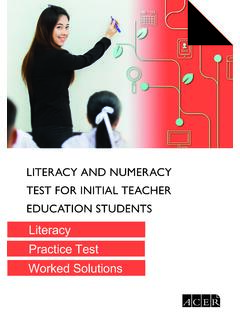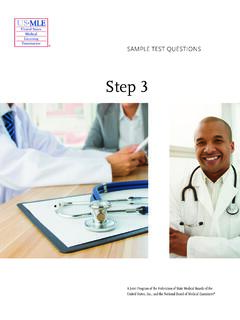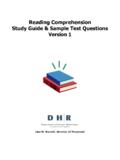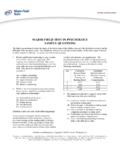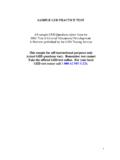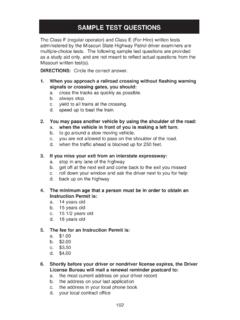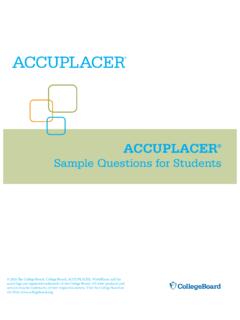Transcription of Literacy and numeracy test for initial teachers: sample ...
1 Literacy AND numeracy . TEST FOR initial TEACHER. EDUCATION STUDENTS. sample Questions Australian Council for Educational Research Literacy sample Questions Answers to the Literacy questions are provided on page 8. Literacy sample QUESTIONS 1 TO 6. Questions 1 to 6 relate to the passage Change in Schools. CHANGE IN SCHOOLS. This text is taken from the introduction to Dancing on a Shifting Carpet: Reinventing traditional schooling for the 21st century (2010). The contemporary context for schools is often referred to as the knowledge era' or the knowledge society', characterised by the constant creation and recreation of knowledge; the speed, complexity and interactivity of innovation; and the need for openness to new learning and new ways of thinking about and doing things.
2 The level of change brought about by the knowledge era, and the pressures of other global and technological changes mentioned earlier, inevitably have an impact on schools. These pressures originate from both external and internal sources. There are external pressures on schools to fix the many social problems caused by rapid change, and to prepare students to live and work in the knowledge society. There are also internal pressures within schools because their clientele students and families have changing expectations and needs. Within the wider external context, schools are seen as instruments of social change and are frequently expected to cure or avert many societal ills by, for example, providing sex and drug education; increasing students' environmental awareness; educating young people in matters of health and engaging them in physical and emotional activities to improve their wellbeing and reduce obesity; and enhancing students'.
3 Commitment to social justice. Within schools, the formal academic curriculum has been expanded to meet the social and psychological needs of students. In increasingly fragmented societies, schools are expected to be havens of peace, safety and stability, while still meeting the academic standards set by governments and the social and psychological expectations of families and communities. Teachers and other school leaders are expected to be constantly available and responsive to parents and their concerns, and schools are often held accountable for matters occurring outside regular school hours, which were traditionally the domain of parents and families.
4 When mistakes happen at school, there is a tendency for parents to blame teachers and other school personnel, and to seek legal redress. All these factors have numerous implications for schools, not the least of which is that they need to change their forms of educational delivery to meet the needs of, and be relevant to, 21st century young people. Back in the late 1980s, Papert and Freire ( ) clearly foresaw the need for schools to change rapidly, even radically, if they were to remain vital to society: .. it is inconceivable that school as we've known it will continue.
5 Inconceivable. And the reason why it's inconceivable is that little glimmer with my grandson who is used to finding knowledge when he wants to and can get it when he needs it, and can get in touch with other people and teachers, not because they are appointed by the state, but because he can contact them in some network somewhere. These children will not sit quietly in school and listen to a teacher give them pre- digested knowledge. I think that they will revolt. (Part 2). Literacy AND numeracy TEST FOR initial TEACHER EDUCATION STUDENTS. sample Questions 3.
6 The revolt may not have happened as yet, but the Australian Government is now talking about the need for a revolution in education and schools (Department of Education, Employment and Workplace Relations, 2008). The core of this revolution' focuses on the quality of teaching, the quality of learning and the quality of student outcomes. Conventional teaching and learning modalities are under widespread critique. Source: Leoni Degenhardt & Patrick Duignan, Dancing on a Shifting Carpet: Reinventing traditional schooling for the 21st century. ACER Press, 2010.
7 Literacy sample question 1. The changes in schools recommended in the text can best be summarised as A increasing academic rigour. B responding to a range of competing demands. C prioritising community wishes over government directives. D using technology to achieve traditional goals more successfully. Literacy sample question 2. According to the text, how do parents tend to respond to problems at school? A by blaming societal ills B by blaming someone in the school C by calling for increased resourcing D by calling for the curriculum to be expanded Literacy sample question 3.
8 Schools are expected to be havens of peace, safety and stability .. (paragraph 4). According to the text, why is this more expected of schools today than in the past? A because society no longer gives this kind of support B because these qualities have been shown to enhance learning C because authorities are committed to avoiding student revolts D because parents have given up on trying to control their children 4 Literacy AND numeracy TEST FOR initial TEACHER EDUCATION STUDENTS. sample Questions Literacy sample question 4. Back in the late 1980s, Papert and Freire ( ) clearly foresaw the need for schools to change rapidly, even radically, if they were to remain vital to society.
9 (paragraph 5). Which word in this sentence indicates that the writers endorse the position of Papert and Freire? A clearly B rapidly C radically D vital Literacy sample question 5. How does the quotation from Papert and Freire relate to the rest of the text? A It summarises the text's main position. B It documents the origin of the text's main idea. C It suggests a solution to a problem raised in the text. D It provides a more extreme point of view than the text. Literacy sample question 6. Papert and Freire refer to the learning experience of a contemporary child (my grandson).
10 Do Papert and Freire identify the features listed below as part of this child's learning experience? Select Yes' or No' for each feature. Feature Yes No immediacy diverse sources of information respect for authority Literacy AND numeracy TEST FOR initial TEACHER EDUCATION STUDENTS. sample Questions 5. Literacy sample QUESTIONS 7 TO 10. Questions 7 to 10 relate to a school history excursion, described in the following passage. HISTORY EXCURSION. Our Year 9 students will be spending two weeks in a rural community to learn more about life there. Students will focus on issues that have affected these settlements over time.




